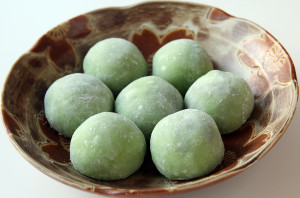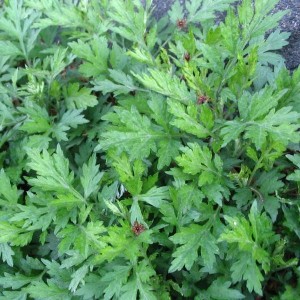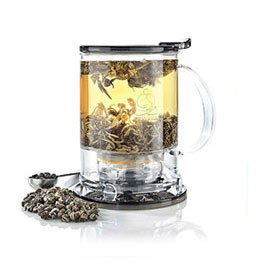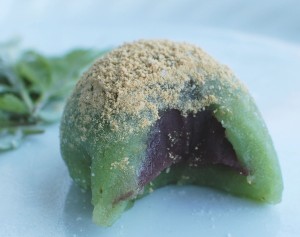 Yomogi (Artemisia princeps)
Yomogi (Artemisia princeps)
This fragrant herb is related to the famous aromatic oil in the green liquor ‘Absinthe’. Yomogi leaves are an essential Japanese confectionery, with its fresh, springlike fragrance and vivid green coloring.
Yomogi is of the chrysanthemum family, and it grows in all areas of Japan except for Hokkaido. It grows wild on the hills, fields, riverbanks and roadsides. Yomogi is a very hardy plant, and its leaves have jagged edges and white fuzz on their undersides. Besides chlorophyll and dietary fiber, it contains Vitamin A, B1, B2 and C, as well as minerals such as iron, calcium and phosphorus. Since the leaves contain cineole and other essential oils, they give off a fresh, spring-like fragrance.
Uses of Yomogi
In Japan it is called よもぎ and the leaves are blanched and added to soups or rice. Yomogi is a vital ingredient of Japanese confectionery, including kusa-mochi or yomogi-mochi (rice cake with yomogi) and hishi-mochi (lozenge rice cake), which is served in Japan at the Doll’s Festival in March.
Beside making rice cakes, the Japanese use Yomogi leaves for bathing (Yomogi Yu), making soap (Yomogi Sekken) and making tea. Use yomogi in a bath to relieve muscular aches and pains, or in a footbath for tired, swollen feet.
Yomogi is used extensively in Chinese medicine. The fuzz on the underside of the leaves is gathered and used in moxibustion. In traditional medicine it is also boiled and sipped to relieve colds and coughs. Its juice is thought to be effective at stopping bleeding, lowering fevers and purging the stomach of impurities. In some regions, there is an ancient custom of hanging yomogi and iris leaves together outside homes in order to keep evil spirits away. It is said that evil spirits dislike their fresh fragrance.
Yomogi around the world
In China it is known as huang hua ai. In Korea, it is called ssuk (쑥) or tarae ssuk (타래쑥) which is related to Dangun Sinhwa (단군신화), the legend of Gojoseon, the first Korean kingdom. It is widely used in Korean cuisine and medicine. It is used for making tteok (rice cake), jeon (Korean style pancake), ssuk kimchi, (쑥김치), and ssukguk (쑥국, soup made with ssuk).
Yomogi Recipes
 Yomogi Tea
Yomogi Tea
In Japan and China, Yomogi Tea is used medicinally. Herbal teas are best brewed when the water is at around 98 °C (208 °F). For a single cup of yomogi tea use 1 to 1 1/2 teaspoons (or 1 pearl) of dried yomogi leaves. Like water temperature, steeping time varies depending on the tea. The best time is between 3 and 4 minutes.
About Japanese Ingredients [1]
For the following recipes you will need to buy either Shiratamako (白玉粉) or Dango-ko (団子粉). Shiratamako is a type of glutinous rice flour (also called sweet rice flour) that is made from mochigome (もち米/糯米, glutinous short grain Japanese rice). Dango-ko is a rice flour for making dango (rice dumplings). It is a mixture of 80% joshinko and 20% mochi-ko rice flours. Joshinko is another rice flour. Kinako is roasted soy bean flour. Anko is sweet red Adzuki bean paste. Tsubu-an is chunky Azuki bean paste. All are available from specialist Japanese grocers.
Easy Yomogi Shiratama or Yomogi Dango
Source: cookpad.japan
Makes 8 sweet rice cakes
Ingredients
1 handful of yomogi leaves or 1 tablespoon of ground yomogi
a pinch of baking soda
3 tbsp shiratamako rice flour or dangoko rice flour
20 ml water
To garnish:
1/2 cup kinako (roasted soy bean flour)
Directions
- If the yomogi is fresh, boil it with a pinch of baking soda. If it is dried and powdered, skip the first 2 steps and place the yomogi straight into a bowl or food processor.
- Soak in water to fix the color. Then squeeze out the water and grind it, using a pestle and mortar or a food processor. There would be some fibers left but never mind about the small ones.
- Add the flour into the mortar, processor or bowl. Add water little at a time and adjust.
- Knead all the yomogi until it is soft and resembles a green papery clay.
- Shape the dough into eight rounds and make a little dent in each one.
- Drop into boiling water. When the rice cakes come floating up to the surface, turn down the heat and simmer for 1 minute.
- Remove the rice cakes with a slotted spoon and put them into cold water.
- To serve, sprinkle with roasted soy bean flour (Kinako) and ice cream.
- It is also possible to freeze. Defrost by boiling.
 Easy Microwave Kusa-Mochi
Easy Microwave Kusa-Mochi
Source: cookpad.japan
Ingredients
20 grams fresh yomogi leaves
70 grams tsubu-an
20 grams sugar
75 grams joshinko
25 grams shiratamako
100 ml hot water
3 grams baking soda
Directions
Wash the yomogi leaves.
Boil 1 litre water in a saucepan and add baking soda.
Add the yomogi into the water and blanch. Wash it a few times then leave it to soak in cold water.
Gently squeeze any excess water out of the yomogi.
Finely chop the yomogi with a knife and then grind it into a paste with a pestle and mortar. If you don’t have a pestle and mortar, you can blend it in a food processor instead.
Split the tsubu-an into 5 portions and roll each portion into a ball.
Add the joshinko, shiratamako and sugar into a bowl and lightly mix them.
Gradually add the hot water and mix everything together well so that there are no lumps. Use your hands if you wish.
Lightly wrap the mixture and heat it in the microwave for 2 minutes at 500 Watts.
Wet a wooden spatula and mix the paste well until it gathers into a ball of mochi dough.
Place the dough in the same mortar as the yomogi paste.
Mix the mochi dough and yomogi paste well with a wooden pestle until the yomogi paste is distributed evenly.
Keep your fingers wet and split the mochi dough into 5 portions. Then stretch out each portion and use one portion to wrap each ball of tsubu-an.
These kusa-mochi are likely to stick to the plate they’re served on so it’s easiest to serve them on top of a dusting of kinako.
Steamed Kusamochi (Rice Cakes with Yomogi)
Source: Masumi Takahashi / Natsuko Hosokawa / Keiko Mori
Bunkyo Women’s College
Serves four (about eight pieces)
Ingredients
- Yomogi leaves 100 g
- Baking soda a pinch
- Rice powder 200 g
- Boiling water 160-180 g
- Red bean paste 200 g
- Soybean flour to taste
- Sugar a pinch
Instructions
1. Wash the yomogi leaves, and put them with the baking soda in a pot of boiling water. Boil for one or two minutes.
2. Drain the leaves and grind them in a mortar.
3. Mix the boiling water with the rice powder and knead it until it becomes soft.
4. Put the rice dough into a steamer and steam for about fifteen minutes.
5. Knead the steamed rice dough together with yomogi.
6. Form it into balls and fill them with red bean paste.
7. Sprinkle soybean flour on the rice cakes. Enjoy!
[1] Japanese rice flour varieties can be divided into 2 categories: made from urumai (regular Japonica white rice) and mochigome (glutinous rice). The properties are very different. You should be careful with using non-Japanese kinds for Japanese confectionery (wagashi). Rice flour is generally called 米の粉 kome-ko. It is a finely powdered rice flour that helps ingredients retain their moisture and is used almost exclusively for Japanese sweets. There are also special rice flour kinds for baking western style cakes and pastries.



